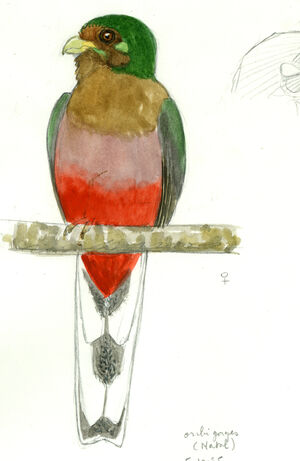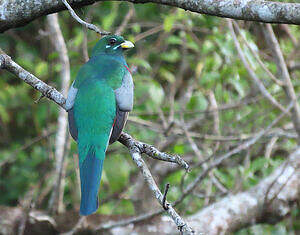Narina Trogon
Apaloderma narina - Trogon narina
Identification
Narina Trogon, the name for this African trogon, comes from a surprise discovery. In 1815, British ornithologist James Francis Stephens recorded the species, but it was actually French ornithologist Francois Levaillant who first spotted it in South Africa. Levaillant became friends with Dutch ornithologist Jacob Temminck, who funded his expedition to Africa from 1781 to 1784. Levaillant brought back over 2,000 bird skins, including the Narina Trogon's, whom he named after the Hottentot word for flower. French ornithologist René Primevère Lesson disputed Levaillant's name, revealing that it was given to honor a young woman with whom the explorer had a romantic attachment. The male Narina Trogon has a long, pale yellow beak with a pale blue tip and visible bristles at the base. It has a narrow, light blue eye brow and an eyeshade that extends from its beak, as well as a distinctive yellow-blue eye ridge, both of which distinguish it from other African Apaloderma trogons. Its metallic green head, neck, mantle, back, and scapulae have blue highlights, while its chest is colored green like the back. Its flanks, belly, and undertail are red. Its primaries are black with white edgings, while the rest of its plumage is grayish black with thin, white lines.The three outer pairs of rectrices are white and the two central pairs are dark blue-green. The female has a pale yellow beak with a blue-yellow mark, a brown iris surmounted by a thin pale blue eyebrow, and the same blue-yellow mark is visible behind the eye; the forehead, throat, parotids and chest are brown-cinnamon. A wide pale pink band between the chest and the red abdomen is visible. The crown, nape, mantle and back are green, the small and medium coverts and the tertiary remiges are vermiculated black and white, the black primaries retain the white edgings of the male. The outer white rectrices are greyed in the centre and the central rectrices are dark blue-green like those of its companion. The tarsi are dark pink. The juveniles resemble their mother, the back is pale green with brown reflections, the coverts and remiges are chamois sprinkled with white marks, the marks visible on the head in the extension of the beak, the eyebrow and the back of the eye are white and it will take many months before the male and female characteristics appear. Six subspecies are recognized, ssp narina in southern Africa has been described above; ssp littorale, found on the east coast of Africa, is smaller, the male has the back and chest green-bronze, the abdomen is paler, the head marks are brilliant blue-green, the female has a paler chest; ssp brachyurum, from Cameroon to Uganda in Central Africa, the male has the back and chest blue-green, the coverts have finer and darker vermiculations, the head spots are blue-green rather than blue, the tail is shorter, the female has a greyer than brown head and chest, the head marks are, like the male, blue-green and the tail is also shorter; ssp constantia, confined to West Africa, does not have the small and medium green coverts with vermiculated marks but has directly striped black and white coverts, the head marks, eyebrow, back of the beak and eye are yellow, the beak is yellowish green, the outer rectrices of the tail are bluish, the female has bluish-grey marks; ssp rufiventre, from Central Africa from the south bank of the Congo to Botswana, with back and chest green-bronze, the abdomen shows a brighter red; ssp arcanum, from Chad to Ethiopia, has the same appearance as rufiventre but with a longer tail. Narina Trogon.
Subspecific information 4 subspecies
- Apaloderma narina narina (Ethiopia to Angola and South Africa)
- Apaloderma narina constantia (Sierra Leone to Ghana)
- Apaloderma narina brachyurum (se Nigeria and Cameroon to DRCongo and Uganda)
- Apaloderma narina littorale (s Somalia to e Tanzania and Mozambique)
Foreign names
- Trogon narina,
- Trogón de Narina,
- republicano-comum,
- Narinatrogon,
- kantáros trogon,
- Narinatrogon,
- Trogone narina,
- narinatrogon,
- Narinatrogon,
- trogónovec narina,
- trogon uzdičkový,
- Narinatrogon,
- afrikantrogoni,
- Bosloerie (Narinatrogon),
- trogon narina,
- afrotrogon zielony,
- Уздечковый африканский трогон,
- アフリカキヌバネドリ,
- 绿颊咬鹃,
- narinatrogon,
- 綠頰咬鵑,
Voice song and call
The male is mostly the one heard, perched between 7 and 20 metres from the ground, below the canopy, it raises its tail vertically, it begins with a very slow and weak whoou-whoou that grows in volume and the phrase can be from 4 to 15 notes long. The singing can also be a repeated roo-kook, started in the same way. Very often, the male will answer one or more other males, during mating season, it will emit a kuk-kuk which can be repeated up to a dozen times, during incubation, it will use the same call to call its mate. In cases of danger, its alarm cries will be of the kind kwaurr or koor, slightly coarse.
Habitat
Trogons usually are associated with particular biotopes, but the Narina Trogon is widely distributed in Africa.
Behaviour character trait
Normally sedentary, wandering of young individuals can be observed in West Africa. Scottish ornithologist Philipp Alexander Clancey (1917-2001), a specialist of the South-African avifauna, noticed that some individuals left the very South of the Province of the Cape and Transvaal to reach Zimbabwe and Malawi during Austral winter (May-August), and other types of migration were observed in the Natal from November to January during the breeding period, where the Narina Trogon can reach up to 1250m or more.
Clancey also noticed that in the South of Mozambique, population increases with the arrival of trogons from South Africa during the dry season (December - March). With the arrival of these immigrants, the resident trogons (ssp littoral) sometimes move to Zimbabwe from November to April! In Malawi and Zambia, they can wander in October at the beginning of the rainy season looking for calmer territories and food.Dietfeeding habits
Narina Trogon, a carnivore and insectivore, is an opportunistic hunter that can often be seen hunting from a low branch; all types of arthropods, lepidoptera, caterpillars, spiders, mantises, cicadas, grasshoppers, various larvae, and termites. It is fond of reptiles; lizards and amphibians: small lizards and chameleons are regularly on its menu.
Reproduction nesting
The breeding periods are very extended, given the very high distribution area of the Narina Trogon: probably all year round in Gabon, Zaire (females in breeding period observed in January, April and September), March to June in Ethiopia and November in Uganda, December in Angola, December-January in Zimbabwe and October to January in South Africa. The Narina Trogon is monogamous and males are extremely territorial, more so than the majority of other trogonids, the territory of a couple covering an area of 1 to 10 ha. During the breeding periods, males can gather in groups of around 3 to 10 individuals who will sing and engage in pursuits from one branch to the next, they display their white outer rectrices when in short flights and when settling on a branch they will again show these white rectrices by raising their tails horizontally and fluffing the breast feathers.
These group displays, observed in Kenya in late October, take place in the morning and last for one to one and the half hours, before the paired males join their companions. The same type of observation has been made in Gabon and Ethiopia, single females are responsive to the call of the males; conversely, British ornithologist Leslie Hilton Brown (1917-1980) observed in Ethiopia in 1968 a male leaving a group of males to go directly to meet a female and copulate with her. The nest is usually at about ten metres from the ground in a cavity of an old tree but can sometimes be lower, the entrance is small and just big enough for one individual, the chamber is spacious and the same nest can be used for several years. A hatch has one to four white colored eggs being laid at 24 hour intervals, the pair incubates in alternate turns, the male during the day and the female at night, the incubation lasts from 18 to 21 days.After about 10 days, the young hatchlings of the Narina Trogon start to grow feathers. Apparently, the male takes on more frequent feeding duties. The juveniles leave the nest between 25 and 28 days and remain in proximity, continuing to be fed by their parents for approximately 60 days. The baby Narina Trogons are subjected to significant predation: ants! Squirrels that go after the eggs! Diurnal raptors such as the Tawny-flanked Prinia, White-breasted Snake Eagle, Ovampo Sparrowhawk or nocturnal raptors such as the African Owl.Geographic range
Given the six recognized ssp, the Narina Trogon's distribution range is vast! Ssp narina bears the species name, ranging from the Cape province in South Africa, Mozambique, Zimbabwe, and Malawi; ssp littorale from southwest Somalia east to Kenya, Tanzania, Mozambique, Malawi, and Zimbabwe; ssp brachyurum from southern Cameroon north to the Congo River Valley in Kenya; ssp constantia in Guinea and Sierra Leone and east to Nigeria; ssp rufiventre from the Congo River south, east and south to Uganda, west to Tanzania, and west to Malawi; ssp arcanum ranging from Lake Chad to Ethiopia and Somalia, northeast to Kenya.
Threats - protection
IUCN conservation status
concern
in the Wild
threatened
evaluated
LC: The Narina Trogon does not appear to be in danger, its huge distribution range across a large part of the African continent being a guarantee of stability for this species, which seems to be adapting to the different African biomes.
Sources of information
- IOC World Bird List (v15.1), Gill, F and D Donsker (Eds). 2025-12-07.
- A Natural history of the Trogonidae, Joseph M.Forshaw Albert Earl Gilbert
- Birds of Southern Africa, Ian Sinclair, Phil Hockey, Warwick Tarboton
- Scientific Birds Names, James A.Jobling
- Vol. 6 - Handbook of the Birds of the World, Josep del Hoyo-Andrew Elliott-Jordi Sargatal
- xeno-canto, Sharing bird sounds from around the world,
- ARKive, Christopher Parsons
- Avibase, Lepage Denis
- BirdLife International, BirdLife International
- HBW Alive,
- Wikipédia, Wikipedia, The Free Encyclopedia
- The internet Bird Collection,
Other sources of interest
 Specification sheet created on
31/07/2023 by Anne et Gabriel Leboff
Specification sheet created on
31/07/2023 by Anne et Gabriel LeboffTranslation by AI Oiseaux.net
© 1996-2025 Oiseaux.net
- Accipitriformes
- Aegotheliformes
- Anseriformes
- Apodiformes
- Apterygiformes
- Bucerotiformes
- Caprimulgiformes
- Cariamiformes
- Casuariiformes
- Charadriiformes
- Ciconiiformes
- Coliiformes
- Columbiformes
- Coraciiformes
- Cuculiformes
- Eurypygiformes
- Falconiformes
- Galliformes
- Gaviiformes
- Gruiformes
- Leptosomiformes
- Mesitornithiformes
- Musophagiformes
- Nyctibiiformes
- Opisthocomiformes
- Otidiformes
- Passeriformes
- Pelecaniformes
- Phaethontiformes
- Phoenicopteriformes
- Piciformes
- Podargiformes
- Podicipediformes
- Procellariiformes
- Psittaciformes
- Pterocliformes
- Rheiformes
- Sphenisciformes
- Steatornithiformes
- Strigiformes
- Struthioniformes
- Suliformes
- Tinamiformes
- Trogoniformes






























